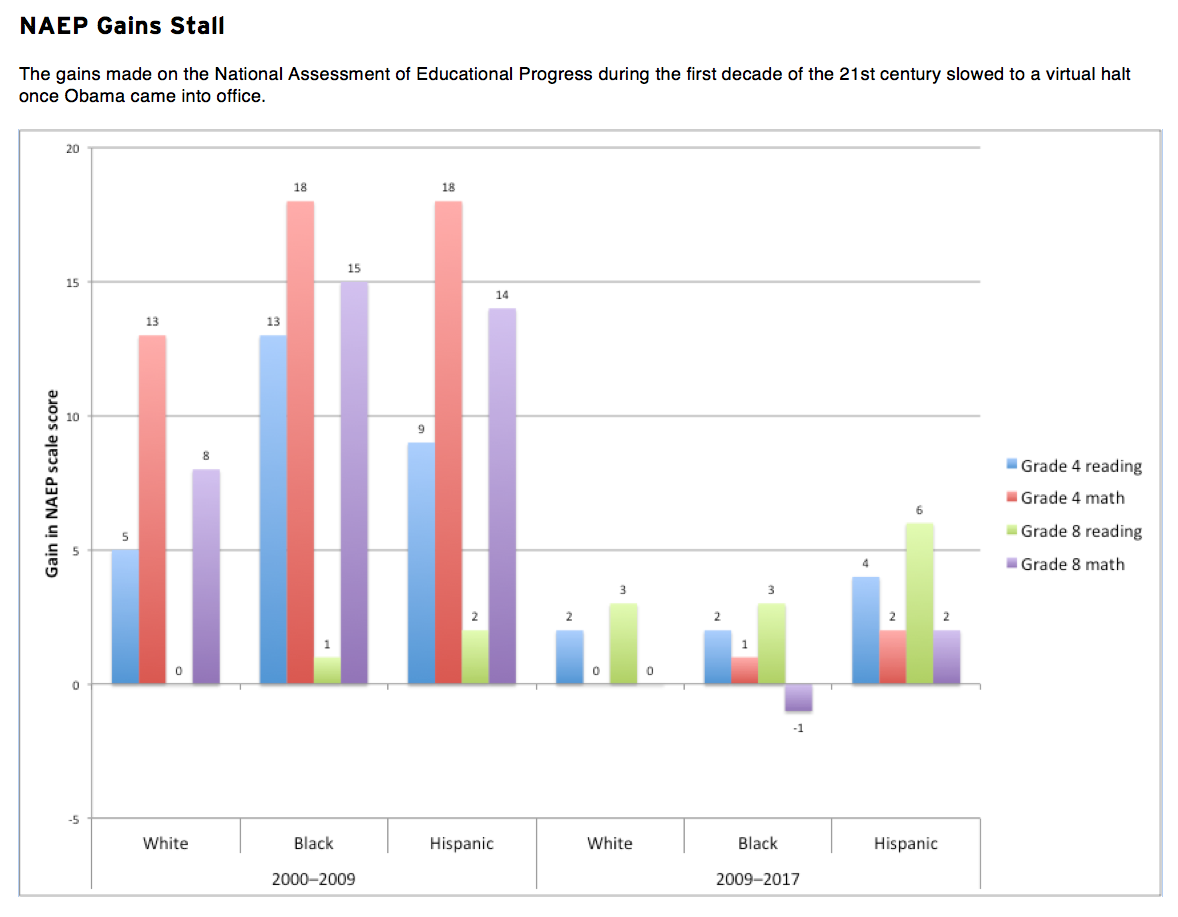D minus. That’s the generous grade to give the Obama Administration—based on student test performances in math and reading over the eight years it held office (2009-2017). Its final grade became apparent just this week when the National Assessment of Educational Progress (NAEP), the official report card for U. S. schools nationwide, released the 2017 results. Student gains registered over the Obama years were trivial at best, far short of those accomplished during what must now be referred to as the halcyon days of the George W. Bush Administration.
Under Bush (2000-2009), racial and ethnic gaps were finally beginning to close—without penalizing white students. Black and Hispanic 4th grade math scores leaped forward by 18 points; in reading these gains were a laudable 13 points and 9 points. Whites trotted along as well, marching forward by 13 points in math and 5 points in reading. In 8th grade math, the gains were 15 points for blacks, 14 points for Hispanics, and 8 points for whites. Only in 8th grade reading does NAEP fail to find significant nationwide gains (Figure 1).
President Obama scolded the nation for perpetuating racial and ethnic gaps, but his Department of Education did nothing to reduce achievement differences, the one disparity that counts. No substantively significant nationwide gains were registered for any of the three racial and ethnic groupings in math or reading at either 4th or 8th grade. Let me repeat: NO GAINS WERE REGISTERED FOR BLACK, HISPANIC, OR WHITE STUDENTS. NONE. The best that can be said is that Hispanics gained six points in 8th grade reading over the 8 years. That’s a free-fall from the days of double digit gains when Bush Administration enforced the federal accountability law, No Child Left Behind.
Bush officials insisted that schools would focus on the needs of all students only if they were held to close scrutiny by regular testing procedures that carried penalties if goals were not met. The Obama Administration dropped the Bush enforcement mechanisms, criticized the tests as mis-leading, and eventually granted states waivers from all provisions of the federal law. A highly touted grab-bag of more or less meaningless reforms were thrown together under the catchy title, Race to the Top, but little was done to ensure that states would actually implement the proposed changes. The U. S. Department of Education backed Common Core State Standards, a proposal that had little accountability teeth but still managed to provoke both teacher unions and Tea Party enthusiasts. Anti-disciplinary and other educationally harmful regulations poured out of the Department’s civil rights office. Meanwhile, teacher unions were allowed to scuttle meaningful reforms such as merit pay, tenure reform and the curtailing of seniority rights, which leave inner city schools bereft of experienced teachers. Charter schools remain at the margins of the education system.
Excuses for failure will be found, of course. It will be said the 2009 recession depressed the spirits of teachers and students. Fingers will point toward the 2 percent slip in educational expenditure per pupil.
But no one has shown much of a correspondence between national economic trends and student performances. What happens inside classrooms and school buildings is vastly more critical. And if minor variations in educational expenditure have such a profound impact on student achievement, why did students make so little progress when they were tripling?
Some will try to explain the latest results by the new on-line testing protocol that is being introduced. But the NAEP results discussed here are taken strictly from the pencil and paper tests that were also administered to a nationally representative sample of students in 2017.
It is almost certain that Donald Trump will be blamed for the recent test-score results. But the tests were administered in spring 2017, only a few weeks after he took the presidential oath. His actions cannot possibly account for a prior eight-year trend.
Governments are generally held accountable for facts on the ground that take place when they are in power. If the economy booms, the government gets the credit. If no economic growth occurs, it is declared a total failure.
That is precisely the situation in American education. No gains were registered during the Obama years—in contrast to the growth years of the Bush Administration. The release of the 2017 NAEP confirms that fact.
Secretary of Education Betsy DeVos promises to transform schools by emphasizing parental choice. Given the record of the past, one can hardly deny it is time for a change.
— Paul E. Peterson
Paul E. Peterson is the Henry Lee Shattuck Professor of Government and Director of the Program on Education Policy and Governance at Harvard University, a Senior Fellow at the Hoover Institution at Stanford University, and Senior Editor of Education Next.
This post is part of a series from Education Next analyzing the 2017 results from the National Assessment of Educational Progress. Click here to check out the series, and stay tuned throughout the week of April 10 for more analysis




